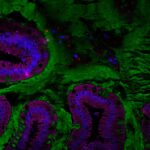Link to Pubmed [PMID] – 26867587
Link to DOI – 10.1186/s12916-016-0573-y
BMC Med 2016 Feb; 14(): 27
The intestinal microbiota is a large and diverse microbial community that inhabits the intestine, containing about 100 trillion bacteria of 500-1000 distinct species that, collectively, provide benefits to the host. The human gut microbiota composition is determined by a myriad of factors, among them genetic and environmental, including diet and medication. The microbiota contributes to nutrient absorption and maturation of the immune system. As reciprocity, the host immune system plays a central role in shaping the composition and localization of the intestinal microbiota. Secretory immunoglobulins A (sIgAs), component of the adaptive immune system, are important player in the protection of epithelium, and are known to have an important impact on the regulation of microbiota composition. A recent study published in Immunity by Fransen and colleagues aimed to mechanistically decipher the interrelationship between sIgA and microbiota diversity/composition. This commentary will discuss these important new findings, as well as how future therapies can ultimately benefit from such discovery.


